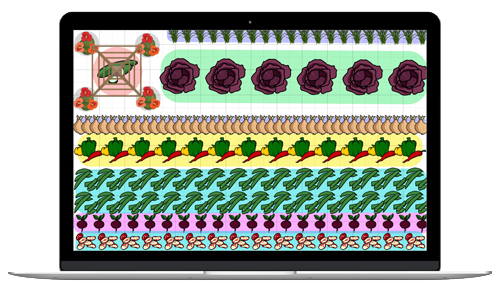
Sunshine on a Stem: Learn Why to Add These Sunny Blooms to Your Garden!
The Almanac Garden Planner - Use It Free for 7 Days!
Plan your 2025 garden with our award-winning Garden Planner.
Types
Marigolds have been stereotyped, but they offer tremendous variety. Both the American and French marigolds are generally aromatic, too, although some folks find the scent to be a bit overwhelming. Keep that in mind when choosing a planting site.
Marigolds have daisy- or carnation-like flower heads produced singly or in clusters. Although there are some 50 species, most marigolds we see in the garden are one of the following:
- Tagetes erecta (aka African marigolds, American marigolds, or Mexican marigolds): This species is the tallest and most upright marigold, reaching 3 to 4 feet in height and producing large, full flowers. According to Nate Dalman of the University of Minnesota Extension, “Despite the names, African marigolds did not originate in Africa and instead are called that because they were first imported to Europe via a trade route that passed through northwest Africa.” They’re native to Mexico and Central America and will thrive even under drought-like conditions.
- T. patula (aka French marigolds): French marigolds tend to be smaller, bushier, and more compact than T. erecta. They are often wider than they are tall. Elegant and eye-catching, they have relatively demure flowers and usually grow from 6 inches to 2 feet tall. They are better suited to rainier conditions than the other Tagetes species.
- T. tenuifolia (aka signet marigolds): These petite marigolds do well in hot, dry sites and make for a beautiful edging plant. They rarely reach more than a foot in height.
French Marigolds (T. patula)
- ‘Little Hero’ Series: 7-inch-tall plants with large, double carnation flowers in 7 color combinations of maroon, orange, and yellow.
- ‘Hero’ Series: 10-inch-tall plants with double carnations, large (2-inch-wide) flowers in 7 different combinations of yellow, orange, and maroon.
- ‘Bonanza’ Series: 2-inch-wide, double carnation flowers in 5 different combinations of yellow, orange, and maroon on bushy, compact 8-inch-tall plants.
- ‘Aurora’ Series: 1-foot-tall plants with wide-petaled, anemone-like flowers in shades of maroon, yellow, and orange.
- ‘Janie’ Series: Early blooming. 8-inch-tall plants are perfect for container growing. Double carnation type flowers in 6 different combinations of yellow, orange, and maroon.
- ‘Boy O’ Boy’ Series: 6-inch-tall prolifically flowering plants with flowers in shades of maroon, yellow, and orange

American/African Marigolds (T. erecta)
- ‘Jubilee’ Series: 2-foot-tall plants with dense, double flowers in shades of yellow and orange.
- ‘Gold Coin’ Series: 1½- to 2-foot-tall plants with large (5-inch-wide) double blooms in gold, yellow, and orange.
- ‘Safari’ Series: 1-foot-tall plants with flat-topped, large flowers in shades of maroon, yellow, and orange.
- ‘French Vanilla’: 3-inch-wide flowers are pure creamy white. Minimal scent. Plants are 1½ to 2 feet tall.
Where to Buy Marigolds
ADVERTISEMENT
I went crazy and planted tons of marigolds, literally by the hand full. They were from the seeds I got from a friend's garden last year. I have been taking the marigolds off when they start looking droopy, but not always turning brown. Last night we had a freeze and so I went out today and took all the flowers off that had turned downwards. I'm worried that even if I let them dry out now, they won't be any good. If I keep only the seeds that are black and not dull white, will I have seeds that are good enough to plant next year?
Hi, Denise: You should, provided that the seeds had time to develop fully. As the saying goes, “… Only one way to find out!” Thanks for asking!
I kept some seeds from my plants I had last year. I recently tried planting some and they are starting to grow. so if I were you I would try planting them. I am having a fun time experimenting with them. :)
How to make f1 marigold plant to grow into healthy plants with big flowers for commercial selling and fertilizers needed.pls help
I expected little detail,the tips given are excellent.
Do you think marigold is the best plant to place around an outdoor pool as a mosquito deterant?
Thanks for the great website.
Deadheading does indeed promote bushier growth; it also encourages blooming. You don’t need to restrict yourself to the center bud. Examine the plant and get rid of any flowers on the wane and edit a few unopened buds–this may seem counterintuitive, but it works! Regular deadheading ensures a longer blooming season. (Be sure you pluck spent flowers before they have time to go to seed.)
Unless of course you want plenty of free seeds for next year. In that case at the very end of your growing season , take the flower heads that have completely dried on the plant , remove them , grab what used to be the flower petals and pull them away from the dried husk . You should now have a hand full of seeds . Please note not all dried flower heads will produce seeds but a fair number will, you willl see the difference. Keep in a dry place till spring , drizzle on the ground where you want then , cover with a light coating of soil water , stand back and let Mother Nature do the rest.
Now collecting dried flowers to have my own seed. Will the seed need to be inside during a freezing winter? And if I cut off the plants
at ground level will they grow back in the spring as priannual?












